|
|
Damselflies - suborder Zygoptera
Order Odonata
This page contains pictures and information about Damselflies that we found in the Brisbane area, Queensland, Australia.

- Damselflies are usually smaller than Dragonflies and with slender body. Their eyes are well separated on each side of the head. Their wings are narrow at the base. Hind wings are similar shape to the forewings. The damselfly larvae have three or occasionally two caudal gills (tails) for breathing in water.
- The insect Order Odonata includes damselflies (this suborder Zygoptera) and dragonflies (suborder Anisoptera). They are medium to large size, body length from 15mm to 120mm. Their bodies are long and slender, usually with bright colours. All of them have two pairs of membranous wings. Their hind wings and forewings are more or less similar size and shape. They have very small antennae but very large compound eyes. They have the small three eyes (ocelli) as well. Their mouths are very good at biting (they don't bite or sting human).


- Damselfly larvae 20mm
-
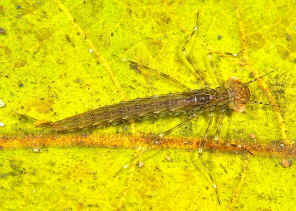

- Damselflies lay eggs in flash water where the larvae grow. Larvae need fairly precise habitat and sensitive to water pollution. Damselfly adult is a predator in the sky and preying on flying insects. Larva may spend years in water, depend on species, while adults live only a few weeks.
- Suborder are further divided into families. Followings listed the damselflies species that we found so far.
Superfamily LESTOIDEA
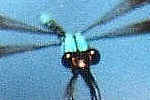 Family Diphlebiidae
- Azure Damselflies
Family Diphlebiidae
- Azure Damselflies
- The Azure Damselflies are all in bright blue colour. This Damselfly family found only in Australia and New Guinea. They are large, thick body and rest with wings spread. Their wings usually have the large dark brown pattern. We found only one species in Brisbane area, the Rockmaster Damselflies, are large, thick body and rest with wings spread so you may think that they are the dragonflies.
- Family Synlestidae - Needles and Whitetips
-
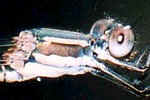 Family Lestidae
-
Reedings
Family Lestidae
-
Reedings - The damselfly in this family has narrow wings and slender body, rests with wings closed. We found only one species of this family in Brisbane. We found them in early summer on the hill top of White Hill in Brisbane where was quite far away from any water. The female damselfly was camouflaged as part of the tip of the stem.
-
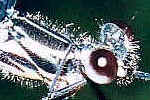 Family Megapodagrionidae
- Flatwings
Family Megapodagrionidae
- Flatwings
- The Megapodagrionidae, or the Flatwings, is another damselflies family which can easily be found in Brisbane area. As their common name implies, when at rest, they spread their wings flat. They are usually metallic in colour, either green, blue or bronze. Females oviposit in tandem with males above the surface of the water and eggs are usually placed in plants.
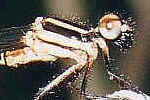 Family Protoneuridae
- Threadtail Damselflies
Family Protoneuridae
- Threadtail Damselflies
- The Threadtail Damselflies are small in size, their abdomen are pin-thin. Their wings are usually clean. We found only one species in Brisbane area. However, they can easily be found near semi-shaded running water. They usually rest in group on the plants at the water edges. They can still be be seen even in winter time. In summer, large number of them can easily be found.
-
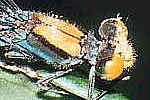 Family Coenagrionidae
-
Pond Damselflies
Family Coenagrionidae
-
Pond Damselflies
- Coenagrionidae is the most abundant damselfly in Brisbane area. They are usually with black pattern, the ground colour may be green, blue, yellow, orange, or purple. Some species are two female colour forms, one of which is similar to the male. Their wings are usually colourless and clear. They prefer to lay eggs in pond or slow running water. Usually they are small and slender.
- More about Dragonflies and Damselflies........................
Superfamily COENAGRIONOIDEA
- Reference:
- 1. Insects of Australia - CSIRO, Division of Entomology, Melbourne University Press, 2nd Edition 1991, p294.
- 2. Insects of Australia and New Zealand - R. J. Tillyard, Angus & Robertson, Ltd, Sydney, 1926, p65.
- 3. The Australian Dragonflies - CSIRO, Watson, Theisinger & Abbey,1991.
- 4. A Field Guide to Dragonflies of South East Queensland - Ric Nattrass, 2006.
- 5. The Complete Field Guide to Dragonflies of Australia - CSIRO, GŁnther Theischinger and John Hawking, 2006.
- 6. Field Guide to Dragonflies of Hong Kong - Keith DP Wilson, Cosmos Books, 2003.
- 7. Northern Territory Insects, A Comprehensive Guide CD - Graham Brown, 2009.
